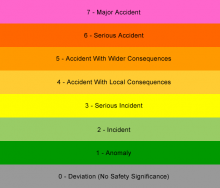The International Atomic Energy Agency (IAEA) introduced the International Nuclear and Radiological Event Scale (INRES ) in 1990 to categorized nuclear accidents to assist in communicating the seriousness and dangers of such events. The scale is logarithmic like the Richter scale for earthquakes. This means that each step up the scale in ten times the intensity of the prior step. Interpretation of severity in nuclear accidents is more subjective than earthquake scaling and a level on the INRES scale can only be assigned after the fact when analysis has been completed. This means that the INRES scale is of limited use in dealing with the immediate problems accompanying a nuclear accident.
Level 0 is called to as a "deviation" and is not a threat to public safety.
Level 1 is called an "anomaly" and may include over exposure of a member of the public in excess of statutory annual limits of radiation exposure, minor problems with nuclear reactor safety components and/or loss or stolen low level radioactivity source, device or transportation package.
Level 2 is called an "incident" and may include exposure of a member of the public to more than ten microsieversts of radioactivity, exposure of a nuclear worker to more than the statutory annual limits, radiation levels of more than fifty microsieversts per hour in a nuclear facility, contamination of an area of the facility that was not designed for exposure, failure of safety provisions with no serious consequences, lost high radioactivity source, device or transport package found with seals intact, and/or inadequate packaging of a high radioactivity sealed source.
Level 3 is called a "serious incident" and may include exposure of nuclear workers to more than ten times the statutory annual limit, non-lethal radiation burns, exposure of more than one Sieverts per hour in a nuclear facility, severe contamination in an area not designed for exposure with a low probability of significant public exposure, accident at a nuclear power plant with no safety provisions still operating, and/or delivery of highly radioactive sealed source without adequate procedures in place to handle it.
Level 4 is called an "accident with local consequences" and may include minor release of radioactive material into the environment that require no countermeasures other than controls on local food production, one or more deaths from radiation, melting or damage to fuel which release more than one percent of fuel in the core and/or release of significant amounts of radioactive materials inside a facility which has a high probability of exposure to the public.
Level 5 is called an "accident with wider consequences" and may include release of radioactive materials into the environment which will trigger planned countermeasures, several deaths from radiation, severe damage to the reactor core, release of large quantities of radioactive material inside a facility with a high probability of significant exposure of the public
Level 6 is called a "serious accident" and consists of significant release of radioactive material into the environment requiring the implementation of serious planned countermeasures.
Level 7 is call a "major accident" and consists of a major release of radioactive material into the environment with widespread health and environmental impacts requiring implementation of planned and extended countermeasures.
Problems with the INRES were revealed when the rating of the 1986 Chernobyl accident in Ukraine was compared with the rating of the Fukushima disaster in Japan. The scale is a qualitative rating system which was designed more for public relations than for scientific classification. There is no definition for an event past Level 7. A new quantitative scale for nuclear accidents has been proposed to address these problems.
